#moss piglet
Text
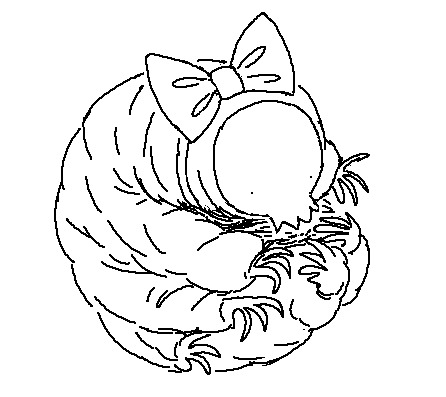
more moss piglet
2K notes
·
View notes
Text
Tardigrade walking across a microscope slide
#Tardigrade#moss piglet#water bear#memes#meme#cute#wholesome#science#serotonin boost#cute animals#wholesome memes#cute animal videos#science memes
313 notes
·
View notes
Text
Wet Beast Wednesday: tardigrades
Last week on Wet Beast Wednesday I covered the largest animals to ever exist on our planet. This week I'm going to pull a full 180 and cover the smallest animals yet on this series. Meet the tardigrade, the internet's favorite micro-animal the is said to be basically immortal. How true is that? Let's see.

(Image: an electron microscope image of a tardigrade. It looks a lot like a potato with eight stubby legs tipped with long claws. At the front is a small, circular mouth. It has no other discernable features. In the background are bits of plant matter that look like seaweed at this scale. End ID)
The tardigrades are 1,300 known species (and probably a lot of unknown ones too) in the phylum Tardigrada. They are also part of the superphylum Ecdysozoa, which are animals that grow by molting their outer cuticles or exoskeletons. In particular, the tardigrades are believed to be a sister group of the arthropods, the group that contains crustaceans, insects, isopods, and a lot of other things. Tardigrades are truly tiny, the largest species reaching a whopping 1.5 millimeters in length, though most species reach no more than 0.5 mm. They have round, segmented bodies with four pairs of legs that end in either claws or suction discs. The body segments consist of a head, three body segments with a pair of legs each, and a caudal segment with the final pair of legs. The first three legs are used for movement while the final pair points backwards and is used for grabbing onto substrate. All of the body segments except for the final one correspond to segments found in the head section of insects. Tardigrades are missing many hox genes, genes that direct the body plan during development. Their ancestors may have had a body plan more similar to insects, but the loss of the hox genes has compressed them into walking heads with a bit of butt. The mouth is tubular and sucks in food. In the mouth are stylets, needle-like structures used to pierce food objects. Once food is drawn into the mouth, a structure called the buccopharyngeal apparatus activates. This is a combination of spines and muscle that acts like an inner jaw that pulls food into the digestive tract. The buccopharyngeal apparatus is distinct enough to be used as a major identifying feature between species. Tardigrades are translucent and many images you've seen of them have false color to show the details or are 3D models based on scanning electron microscope imagery of them. Tardigrades molt their exoskeletons multiple times (up to 12) during their lifecycle. Some species are unable to poop normally and instead all their waste is discarded during the molt. It was formerly believed that tardigrades could exchange genes with each other without mating, a process called horizontal gene transfer that is seen in bacteria, archaea, and other micro-organisms. It has since been discovered that while still capable of horizontal gene transfer, it is quite a bit rarer in tardigrades than we thought.
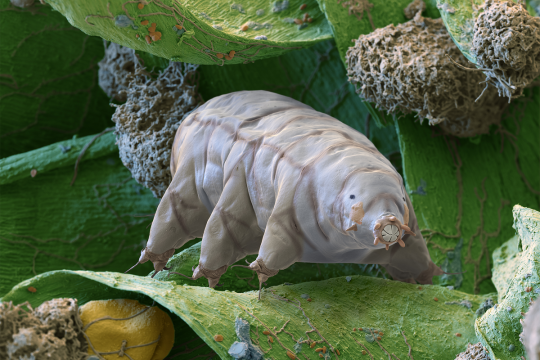
(Image: an electron microscope image of a tardigrade standing on a bit of plant matter. This one has a closed mouth with a ring of triangular tooth-like structures. It also has two simple eyes that look like black dots. End ID)
The name "tardigrade" means "slow walker", which is fitting as, despite their eight legs, tardigrades have a slow and awkward gait. This is the result of their legs being unjointed, only able to pivot at their connection to the body. Their gait has been compared to that of bears, hence why they are often called water bears and their discoverer, Johann August Ephraim Goeze, called them "kleiner wasserbär", meaning "little water bear". Tardigrades are found worldwide and have inhabited virtually every habitat, from the tops of mountains to the deep sea, from hot springs to the antarctic, from freshwater to saltwater. The one thing they have in common is a need to stay wet. Tardigrades can survive out of water as long as they can stay moist and are often found in mosses, hence another common name: moss piglets. The majority either eat plants or bacteria, but some will feed on smaller tardigrades or other micro-animals. Their famous survivability makes it easy for tardigrades or their eggs to be carried to new habitats by larger animals or other phenomena. Tardigrades are one of the first micro-animals to colonize a new habitat and they are a pioneer species, the first species to colonize a new environment and whose presence makes that environment fore suitable for other species to follow. Tardigrades are a major food source to other micro-animals and larger organisms. Most species have distinct males and females, though a few reproduce through parthenogenesis. In most cases, molting female will lay her eggs in her shed cuticle and males will them fertilize them. Other species have a form of internal reproduction. Males and females will court each other before mating and females will usually allow multiple males to fertilize her eggs. Female tardigrades are typically larger and more abundant than males. Eggs can take up to 14 days (species dependent) before hatching. All tardigrades of the same species have the exact same number of cells as each other. They are also born with the same number of cells they will have as an adult. Their growth is driven by enlargement of the existing cells rather than cellular reproduction making new cells. The lifespan ranges between a few months to a few years, depending on species.

(Image: a color photo of a tardigrade. It is a pale, translucent white, making it hard to make out details. Its body is curved, with the front end pointing at the camera. It has two simple eyes. End ID)
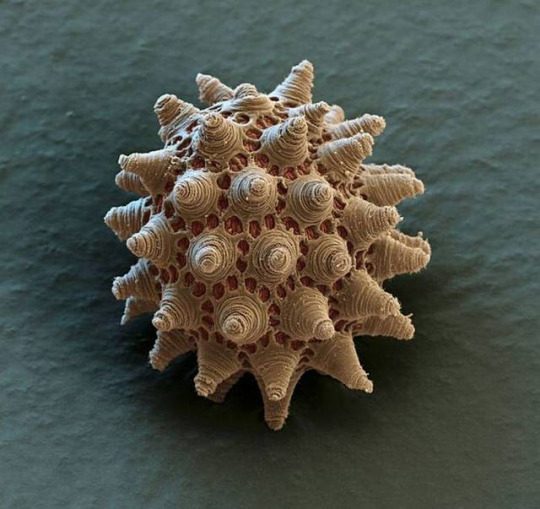
(Image: an electron microscope image of a tardigrade egg. It is round but covered in small pores and conical structures. End ID)
The most famous feature of tardigrades is their legendary durability. It is commonly said that tardigrades can survive just about anything (except for the things that are actually trying to kill them. They are prey to a lot of species after all). Among the things they can survive is extreme heat, extreme cold, dehydration, extremely high and low pressure, exposure to ionizing radiation (that's the scary kind), low oxygen environments, environmental toxins, heavy impacts, and the vacuum of fucking space. While the can survive in extreme conditions, tardigrades are not considered extremophiles. True extremophiles thrive in extreme environments and are negatively impacted by leaving them. Tardigrades can survive in extreme environments, but are negatively impacted and can't survive as well there as they can in less extreme places. The main trait that has allowed tardigrades to survive all five mass extinctions in history is cryptobiosis. Cryptobiosis is the rare ability for an animal to enter a state of dormancy where their metabolic processes come to an almost complete stop. While in cryptobiosis, metabolic activity drops to 0.01% normal and water content drops to 1% normal. In this state, the tardigrade is called a tun. Tardigrades usually enter cryptobiosis in response to arid conditions. One experiment showed that a species of tardigrade could last for at least 30 years in this state and return to normal lifestyle functions when exposed to water. Tardigrades will also enter cryptobiosis in response to low oxygen, toxic chemical exposure, increased or decreased temperature, and excessive salt content in the water. Tardigrades also show extreme resistance to both high and low pressure. They can live in 0 atmospheres of pressure and some species can survive up to 6,000 atmospheres, more than double the pressure at the bottom of the Marianas trench. More interesting is their ability to survive dangerous radiation. They can survive 1,000 times the dose of gamma radiation that humans can. Early tests focused on tardigrades in cryptobiosis and concluded that the extremely low water content of a cryptobiotic tardigrade doesn't leave much opportunity for the radiation to react with the animal. However it was later found that active and fully hydrated tardigrades are still considerably resistant to radiation. Studies into this resistance indicate that tardigrades can very efficiently repair damaged DNA and have unique proteins called Dsup that provides additional protection. Dsup introduced to human cells has provided additional protection against x-rays.
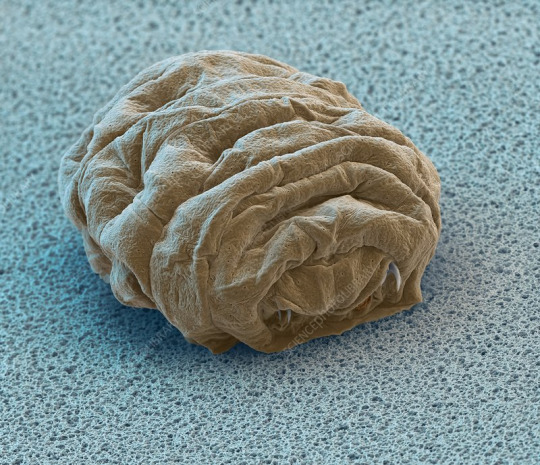
(Image: an electron microscope image of a tun - a tardigrade in cryptobiosis. It is smaller and very wrinkly, with the legs and mouth retracted into the body. End ID)
Tardigrades were the first animals to be exposed to the vacuum of space. They were exposed for 10 days, some in a state of cryptobiosis at the time of exposure and some still active. It was found that they were able to survive the vacuum when shielded from the sun's ultraviolet radiation, with those already in cryptobiosis doing better. Upon being rehydrated, many were able to resume normal life functions and successfully reproduce, though others died after being rehydrated. Those that were exposed to UV radiation fared much worse, with only a few hydrated individuals surviving. The individuals in cryptobiosis had a lower survival rate when exposed to UV than those not exposed to UV and were less successful at reproducing afterwards. Studies of tardigrade's space survival abilities and resistance to radiation could go a long way in helping human space travel. One of the largest dangers of space travel is that space is full of nasty radiation from the sun that Earth's magnetic field protects us from. Some scientists speculate about the possibility of accidentally seeding other planets or moons with tardigrades or other space-resistant organisms. This is a problem because introducing Earth life to other world has the potential to damage any native ecosystems and if we find life in space in the future we don't want to have to figure out if it's something we accidentally put there. While tardigrades could likely survive on other planets, they would eventually die without a food source. Some sources reported that tardigrades may have colonized the moon after an experiment with them crashed. Unfortunately, the moon is not crawling with tardigrades now. It's way too dry for them to exit cryptobiosis even if they survived the crash, which they probably didn't.
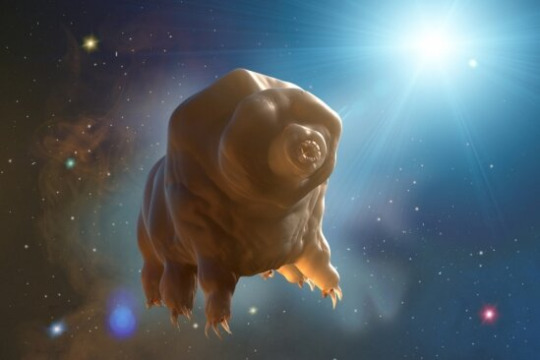
(Image: art of a tardigrade floating in the vacuum of space. End ID. Source: University of California - Santa Barbara)
#wet beast wednesday#tardigrade#water bear#moss piglet#micro animal#microbiology#marine biology#biology#zoology#ecology#animal facts#informative#science#space#astrobiology#radiation#cryptobiosis#tun#image described
155 notes
·
View notes
Text
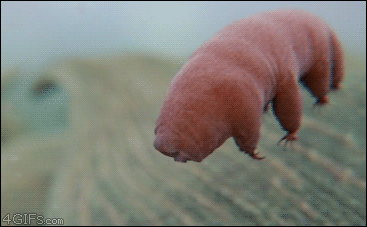
134 notes
·
View notes
Text



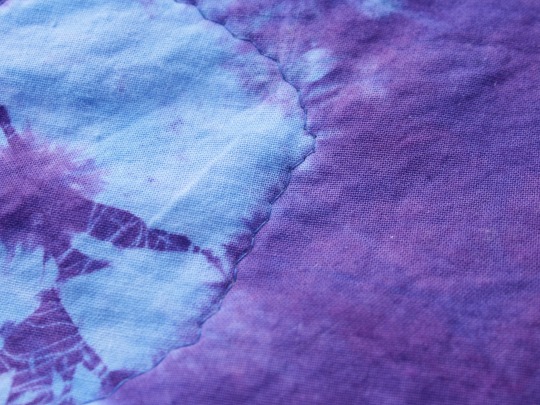

Water Bear Waltz, 2023, hand dyed cotton fabrics, textile discharge, cotton batting, sewing thread and crochet thread
silly little quilt of a silly little creature! this was my first time quilting with a sewing machine (although I had to sneak in some hand quilting too.) The tardigrades are made with textile discharge material to bleach the image, with the large tardigrade being hand painted and the smaller ones scattered throughout printed with a hand carved rubber stamp. all the tie dye was done by hand and tied and redyed multiple times.
#tardigrade#water bear#moss piglet#microscopic#microorganisms#quilt#quilting#fiber art#sewing#tie dye#queer artist
152 notes
·
View notes
Text
Ok so my Tardigrade post now has way more likes than i thought it would, sooo.....
Here's some Tardigrade facts!!
They can survive in extreme areas due to curling up into a little ball called a tun. Tun formation requires metabolism and synthesis of a protective sugar known as trehalose, which moves into the cells and replaces lost water. While in a tun, their metabolism can lower to less than 0.01% of normal.
Tardigrades are also known as water bears or moss piglets! (And gummy bears in the Wild Kratts episode)
The lil guys were first described in 1773 by the German pastor J.A.E Goeze.
They were given the name Tardigrada, which means "slow stepper," in 1776 by the Italian biologist Lazzaro Spallanzani.
They have four pairs of legs!!!! 8 whole legs!!!!! :)
They can reproduce by asexual or sexual reproduction.
Live tardigrades have been regenerated from dried moss kept in a museum for over 100 years
Tardigrades are believed to be related to Arthropoda (insects, spiders, and crustaceans) and Onychophora (velvet worms).
They're only 0.05 - 1.2mm long!
They have little claws at the end of each leg (as seen in picture below 💙)

34 notes
·
View notes
Text
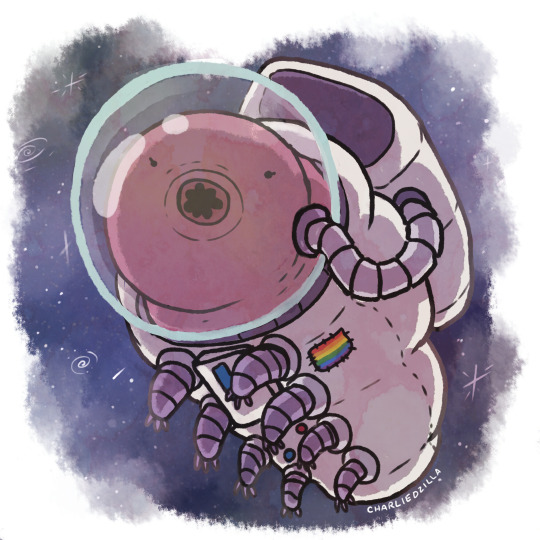
One small step for moss piglet, one giant leap for microoranisms.
284 notes
·
View notes
Text
Hello! I would like to spread knowledge and appreciation to the micro-animals know as Tardigrades, aka Water Bears, aka Moss Piglets, aka these guys!
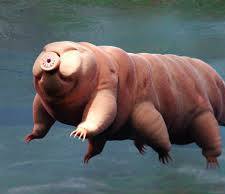
They are super cool because they can survive in the most extreme ph, tempatures, acidities, and even SPACE?
They tend to live near water sources, but are found everywhere from rainforests, to Antarctica, to the driest of deserts!
The largest can be up to .5mm, barely visible to the human eye, but they’re also see through so good luck finding one without a microscope.
Anyway, tardigrades are cool.
#tardigrade#water bear#moss piglet#micro organisms#micro animals#I am a tardigrade#immortal little guys#biology#zoology#science#science side of tumblr
21 notes
·
View notes
Text

Tardigrade Bok globules. Inspired by the Hubble image of a Bok globule nicknamed the "Caterpillar" in the Carina Nebula.
#art#bok globule#space#carina nebula#tardigrade#science fantasy#nebula#fantasy#stars#moss piglet#water bear#scifi art#space art#digital art#orange#blue#hubble#astro artist#cosmos#universe#artists on tumblr
48 notes
·
View notes
Text
I wish I was a
Water Bear
they're built to survive
EXTREME BULLSHIT
22 notes
·
View notes
Text
INVERTEBRATE TOURNAMENT:
Sea Invertebrates CHAMPIONSHIP
It’s been a long road, but finally we can make a choice about which sea invertebrate is best. Our two candidates are both formidable— the Octopus, eight-limbed mollusk and cephalopod, renowned for its intelligence and ability to squeeze through tight spaces, and the Deep Sea Isopod, giant underwater cousin to our land invertebrate champion, the pillbug. Will the octopus’s impressive intellect help it win a victory against this deep sea scavenger? Only one way to find out, so without further ado, let’s get this poll started—
Wait. Hold on, we’re getting reports of a new challenger arriving at the stadium. But that can’t be! This is the championship! What invertebrate would have the audacity to enter the tournament this far in, to challenge the two that beat all the others? And where is this new challenger, anyways? I can’t quite see where they—
NO, No, wait just a moment! The new challenger approaches! A tiny little eight-legged beast known as the Water Bear and Moss Piglet but related to neither, it took a while for this sturdy “slow stepper” to get here but he’s right in time! Everyone meet THE TARDIGRADE!!!!!!!!! What do you think, folks?




#polls#tumblr polls#poll#tumblr poll#invertebrates#nature#nature polls#animals#giant isopod#isopod#deep sea#isopods#arthropods#cephalopod#mollusk#octopus#tardigrade#water bear#moss piglet#microorganisms#sea creatures#sea life#sea animals#marine animals#marine biology#marine life#ocean
6 notes
·
View notes
Text

moss piglet
#scribbles#tardigrade#water bear#moss piglet#bug doodles#reminder you can pay me $5 on kofi to draw a bug for you#'bug' sensu lato#btw i am actually working on some higher-effort drawings but still mostly in my lazy digital scribbles phase#bflyart
3K notes
·
View notes
Text

#tardigrade#memes#herpetology#water bear#gecko#reptiles#herpblr#geckos#little water bear#moss piglet#micro animals#cute animals#cute#lizard memes#lizard
258 notes
·
View notes
Text

Anyone else a fan of journey into the microcosmos? I love things that force me to change my perspective.
73 notes
·
View notes
Text
instagram
3 notes
·
View notes
Photo




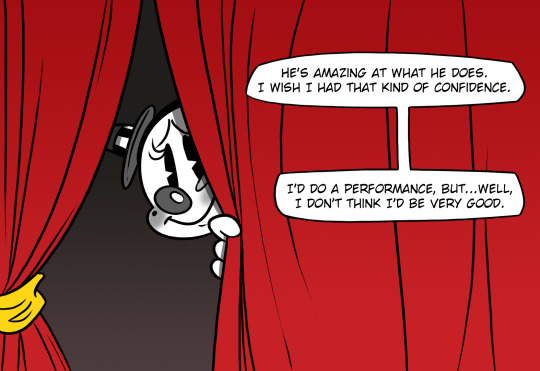

———————————————
DITZY DOLORES
Start at the Beginning || Ask A Question
View / Send Fan Art || Become A Patron
Read Our Other Comics
#chrono#ditzy dolores#clown#theater#vaudeville#askvaudeville#abelard#tardigrade#water bear#moss piglet#broom#edward the wizard#bunny rabbit#oc#ocs#original characters#ask-healthy-light
22 notes
·
View notes